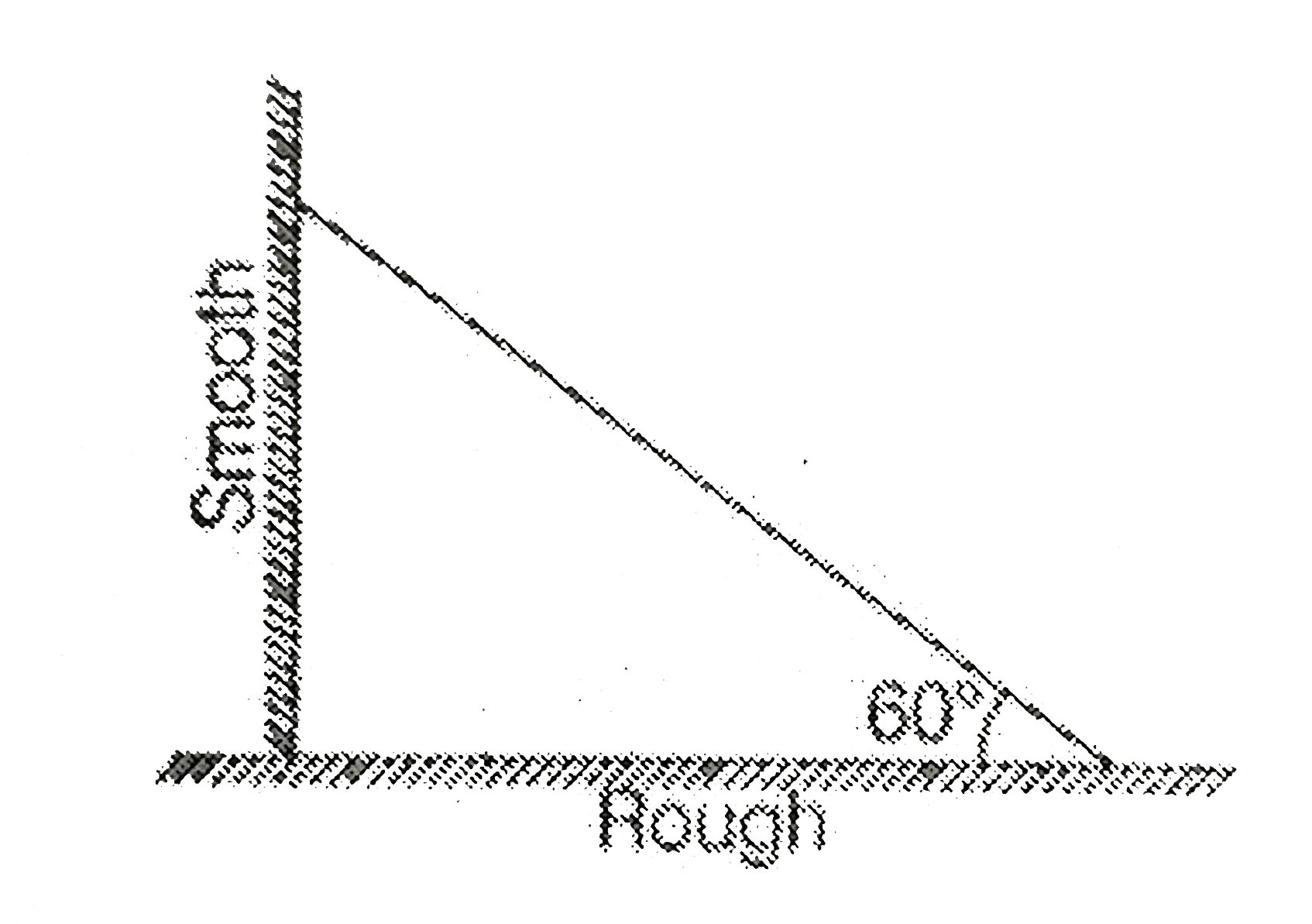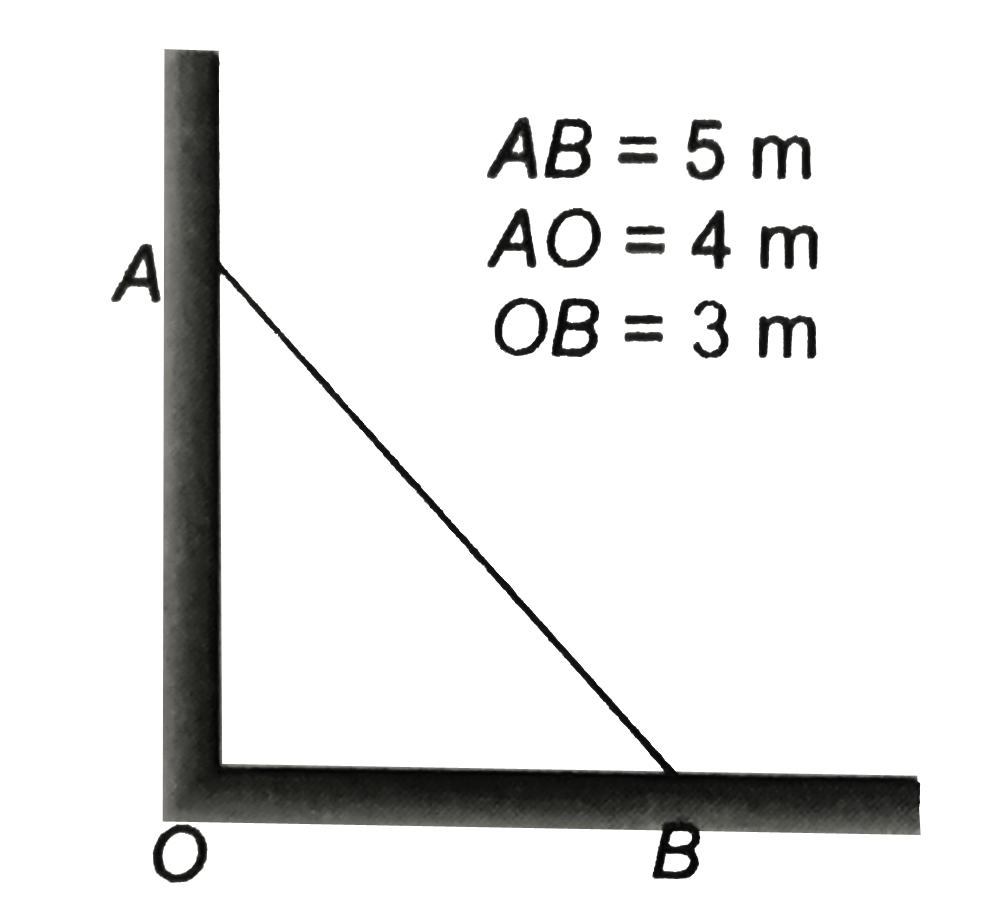A uniform ladder of length 10.0 m and mass 16.0 kg is resting against a vertical smooth wall making an angle of 37∘ with it. An electrian weighing 60.0 kg climbs up the ladder. If the stays on the ladder at a point 8.00 m from the lower end, what will be normal force and the force of friction on the ladder by the ground? What should be the minimum coefficient of friction for the electrician to work safely?
The correct Answer is:A, B, C, D
To solve the problem step by step, we will analyze the forces acting on the ladder and apply the principles of static equilibrium.
Step 1: Identify the forces acting on the ladder
1. Weight of the ladder (W_l): The weight of the ladder acts downward at its center of mass, which is at a distance of 5 m from the base (midpoint of the ladder).
Wl=ml⋅g=16kg⋅9.81m/s2=156.96N
2. Weight of the electrician (W_e): The weight of the electrician acts downward at a distance of 8 m from the base of the ladder.
We=me⋅g=60kg⋅9.81m/s2=588.6N
3. Normal force at the ground (R1): This force acts upward at the base of the ladder.
4. Frictional force (F): This force acts horizontally at the base of the ladder, preventing it from slipping.
5. Normal force from the wall (R2): Since the wall is smooth, this force acts horizontally at the top of the ladder.
Step 2: Apply the equilibrium conditions
For the ladder to be in static equilibrium, the sum of forces in both the horizontal and vertical directions must be zero, and the sum of moments about any point must also be zero.
Vertical Forces:
R1−Wl−We=0
R1=Wl+We=156.96N+588.6N=745.56N
Horizontal Forces:
F−R2=0⇒F=R2
Step 3: Calculate the moments about point A
Taking moments about point A (the base of the ladder):
- Moment due to the weight of the ladder:
Momentl=Wl⋅(102⋅sin(37∘))=156.96⋅(5⋅sin(37∘))
- Moment due to the weight of the electrician:
Momente=We⋅(8⋅sin(37∘))
- Moment due to the normal force from the wall:
MomentR2=R2⋅(10⋅cos(37∘))
Setting the sum of moments about point A to zero:
Wl⋅(5⋅sin(37∘))+We⋅(8⋅sin(37∘))−R2⋅(10⋅cos(37∘))=0
Step 4: Solve for R2
Substituting the values:
156.96⋅(5⋅sin(37∘))+588.6⋅(8⋅sin(37∘))=R2⋅(10⋅cos(37∘))
Calculating the left side:
- sin(37∘)≈0.6018
- cos(37∘)≈0.7986
Calculating:
156.96⋅(5⋅0.6018)+588.6⋅(8⋅0.6018)=R2⋅(10⋅0.7986)
R2=156.96⋅3.009+588.6⋅4.81447.986
Calculating gives R2.
Step 5: Calculate the coefficient of friction
The frictional force can be expressed as:
F=μ⋅R1
Using F=R2:
R2=μ⋅R1⇒μ=R2R1
Final Answers
1. Normal force (R1): 745.56N
2. Frictional force (R2): Calculate from the previous steps.
3. Minimum coefficient of friction (μ): Calculate using the ratio of R2 and R1.
1. Weight of the ladder (W_l): The weight of the ladder acts downward at its center of mass, which is at a distance of 5 m from the base (midpoint of the ladder).
Wl=ml⋅g=16kg⋅9.81m/s2=156.96N
We=me⋅g=60kg⋅9.81m/s2=588.6N
For the ladder to be in static equilibrium, the sum of forces in both the horizontal and vertical directions must be zero, and the sum of moments about any point must also be zero.
R1−Wl−We=0
R1=Wl+We=156.96N+588.6N=745.56N
F−R2=0⇒F=R2
Taking moments about point A (the base of the ladder):
- Moment due to the weight of the ladder:
Momentl=Wl⋅(102⋅sin(37∘))=156.96⋅(5⋅sin(37∘))
- Moment due to the weight of the electrician:
Momente=We⋅(8⋅sin(37∘))
- Moment due to the normal force from the wall:
MomentR2=R2⋅(10⋅cos(37∘))
Wl⋅(5⋅sin(37∘))+We⋅(8⋅sin(37∘))−R2⋅(10⋅cos(37∘))=0
Substituting the values:
156.96⋅(5⋅sin(37∘))+588.6⋅(8⋅sin(37∘))=R2⋅(10⋅cos(37∘))
- sin(37∘)≈0.6018
- cos(37∘)≈0.7986
156.96⋅(5⋅0.6018)+588.6⋅(8⋅0.6018)=R2⋅(10⋅0.7986)
R2=156.96⋅3.009+588.6⋅4.81447.986
Calculating gives R2.
The frictional force can be expressed as:
F=μ⋅R1
Using F=R2:
R2=μ⋅R1⇒μ=R2R1
1. Normal force (R1): 745.56N
2. Frictional force (R2): Calculate from the previous steps.
3. Minimum coefficient of friction (μ): Calculate using the ratio of R2 and R1.
Topper's Solved these Questions
- BOOK - HC VERMA ENGLISHCHAPTER - ROTATIONAL MECHANICSEXERCISE - Questions for short Answer21videos
ROTATIONAL MECHANICS
- BOOK - HC VERMA ENGLISHCHAPTER - ROTATIONAL MECHANICSEXERCISE - Objective -214videos
ROTATIONAL MECHANICS
- BOOK - HC VERMA ENGLISHCHAPTER - REST AND MOTION : KINEMATICSEXERCISE - Question for short Answer13videos
REST AND MOTION : KINEMATICS
- BOOK - HC VERMA ENGLISHCHAPTER - SIMPLE HARMONIC MOTIONEXERCISE - Question for short Answer15videos
SIMPLE HARMONIC MOTION
Similar Questions
A uniform ladder of length 10.0 m and mas 16.0 kg is resting against a vertical wall making an angle of 37∘ with it. An electrician weighing 60.0 kg climbs up the ladder. If the stays on the ladder at a point 8.00 m from the lower end, will be normal force and the force of friction on the ladder by the ground? What should be the minimum coefficient of friction for the electrician to work safely?
View SolutionA uniform ladder of mass 10 kg leans against a smooth vertical wall making an angle of 530 with it. The other end rests on a rough horizontal floor. Find the normal force and the frictional force that the floor exerts on the ladder
View SolutionA ladder is placed against a vertical tower. If the ladder makes an angle of 30∘ with the ground and reached upto a height of 15 m of the tower, find the length of the ladder.
View SolutionA ladder 13 m long rests against a vertical wall. If the foot of the ladder is 5 m from the foot of the wall, find the distance of the other end of the ladder from the ground.
View SolutionA ladder 13 m long rests against a vertical wall. If the foot of the ladder is 5 m from the foot of the wall, find the distance of the other end of the ladder from the ground.
View SolutionA ladder is inclined to a wall making an angle of 30° with it. A man is ascending the ladder at the rate of 3 m/sec. How fast is he approaching the wall ?
View SolutionA ladder of mass 10kg is held at reat against a smooth wall on a rough ground as shown in figure. The normal reaction between the wall and the ladder is
 View Solution
View SolutionThe length of a uniform ladder of mass m is 1. It leans against a smooth wall making an angle θ with the horizontal. What should be the force of friction between the floor and ladder so that the ladder does not slip ?
View SolutionA ladder of length 5m is placed against a smooth wall as shown in figure. The coefficient or friction is μ between ladder and ground. What is the minimum value of μ , If the ladder is not to slip?
 View Solution
View SolutionA ladder of length 5m is placed against a smooth wall as shown in figure. The coefficient or friction is μ between ladder and ground. What is the minimum value of μ , If the ladder is not to slip?
 View Solution
View Solution

